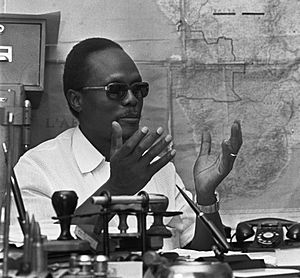Holden Roberto facts for kids
Quick facts for kids
Holden Roberto
|
|
|---|---|

Holden Roberto in 1973
|
|
| President of the FNLA | |
| In office 1954 – 2007 Until 1961 as the Union of Peoples of Angola |
|
| Preceded by | Position established |
| Succeeded by | Ngola Kabangu |
| President of the Democratic People's Republic of Angola | |
| In office 11 November 1975 – 11 February 1976 |
|
| Preceded by | Position established |
| Succeeded by | Position abolished |
| Personal details | |
| Born | 12 January 1923 São Salvador, Portuguese Angola (now M'banza-Kongo, Angola) |
| Died | 2 August 2007 (aged 84) |
| Children | Carlito Roberto, Julietta Roberto, Catarina Roberto, Gracia Roberto, Emmanuel Roberto, Jean-Pierre Roberto, Holden Roberto Jr., Milton Roberto |
Álvaro Holden Roberto (born January 12, 1923 – died August 2, 2007) was an important Angolan politician. He was the founder and leader of the National Liberation Front of Angola (FNLA) from 1962 to 1999. He played a key role in Angola's fight for independence from Portugal.
Contents
Early Life and Education
Holden Roberto was born in São Salvador, in the northern part of Portuguese Angola. His parents were Garcia Diasiwa Roberto and Joana Lala Nekaka. His family had ties to the Royal Family of the Kingdom of Kongo.
In 1925, when he was very young, his family moved to Léopoldville in the Belgian Congo. He went to a Baptist mission school and graduated in 1940. After school, he worked for the Belgian Finance Ministry for eight years. He worked in cities like Léopoldville, Costermansville, and Stanleyville.
In 1949, Roberto returned to Léopoldville. He played football for a local team called "Nomads" with his uncle. He also played for Daring Club Motema Pembe, alongside Cyrille Adoula, who later became the Prime Minister of Congo. In 1951, he visited Angola. There, he saw Portuguese officials treating an old man badly. This event inspired him to start his political journey.
Beginning His Political Journey
On July 14, 1954, Holden Roberto and Sydney Manuel Barros Nekaka created a group called the Union of Peoples of Northern Angola (UPNA). This group later changed its name to the Union of Peoples of Angola (UPA). Roberto became the President of the UPA.
In December 1958, Roberto secretly attended the All-African Peoples Congress of Ghana in Accra, Ghana. He represented Angola at this important meeting. There, he met other future leaders like Patrice Lumumba from Congo, Kenneth Kaunda from Zambia, and Tom Mboya from Kenya. He even got a passport from Guinea and visited the United Nations.
In February 1961, Jonas Savimbi, who would later lead another group called UNITA, joined the UPA. This happened after Mboya and Jomo Kenyatta, the future Kenyan Prime Minister, encouraged him. Later that year, Roberto made Savimbi the Secretary-General of the UPA. The United States National Security Council also started giving Roberto financial support in the 1950s.
Leading the FNLA
After visiting the United Nations, Roberto went back to Kinshasa. He gathered Bakongo fighters and launched an attack into Angola on March 15, 1961. His forces took control of farms, government buildings, and trading areas. This marked the start of a major conflict.
On April 25, 1961, Roberto met with U.S. President John F. Kennedy. In March 1962, Roberto combined the UPA with the Democratic Party of Angola to form the FNLA. A few weeks later, on March 27, he created the Revolutionary Government of Angola in Exile (GRAE). He appointed Savimbi as its Foreign Minister.
Roberto also formed a political alliance with Zairian President Mobutu Sese Seko. He did this by marrying a woman from Mobutu's wife's village. From 1963 to 1969, Roberto also received help from the Israeli government.
In 1964, Savimbi left the FNLA. He then founded UNITA because he felt Roberto was not willing to expand the fight for independence beyond the traditional Kingdom of Kongo areas.
Zhou Enlai, the Premier of China, invited Roberto to visit China in 1964. However, Roberto did not go because Moise Tshombe, the President of Katanga, warned him he might not be allowed back into Congo.
Angolan Independence and Civil War
As Angola was about to become independent from Portugal, Zaire tried to help the FNLA gain power. They sent soldiers and vehicles into Angola. However, a large number of Cuban forces arrived and helped the People's Movement for the Liberation of Angola (MPLA) defeat the FNLA and Zaire's forces. In 1976, the MPLA defeated the FNLA in the Battle of Quifangondo, and the FNLA retreated to Zaire.
Holden Roberto and Agostinho Neto, the leader of the MPLA, had similar ideas for an independent Angola. However, Roberto's support came from western Angola, while Neto's came from eastern Angola. Neto received support from the Soviet Union, while Roberto received support from the United States, China, and Zaire. Roberto strongly opposed Neto's idea of uniting all Angolan rebel groups. He worried that the FNLA would be taken over by the MPLA. This led to serious conflicts between the groups.
Later Life and Legacy
In 1991, the FNLA and MPLA signed the Bicesse Accords, which allowed Roberto to return to Angola. He ran for president but did not win, getting only 2.1% of the votes. However, the FNLA did win five seats in the Parliament, but they chose not to join the government.
Holden Roberto passed away on August 2, 2007, at his home in Luanda. After his death, President José Eduardo dos Santos praised him. He said that Holden Roberto was "one of the pioneers of national liberation struggle, whose name encouraged a generation of Angolans to opt for resistance and combat for the country's independence." The president also set up a special group to arrange his funeral.
See also
 In Spanish: Holden Roberto para niños
In Spanish: Holden Roberto para niños

